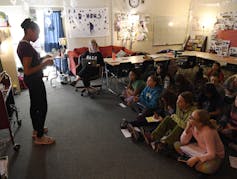Amanda Gorman's poetry shows why spoken word belongs in school
- Written by Kathleen M. Alley, Associate Professor of Literacy, Mississippi State University
Editor’s note: Not long after Amanda Gorman recited one of her poems at the inauguration of President Joe Biden on Jan. 20, three of her forthcoming books skyrocketed to three of the top four spots[1] on Amazon. She was also selected to recite an original poem at Super Bowl LV[2]. Here, three scholars of poetry explain why the writings of the 22-year-old Gorman – who became the country’s national youth poet laureate at age 17 – and her rise to fame represent a prime opportunity for educators to use spoken word poetry as a lively way to engage students.
Wendy R. Williams, assistant professor of English at Arizona State University
During my research studying a diverse group of spoken word poets in Arizona[3], I learned that adolescents improved their writing skills, academic performance, confidence and social skills through writing and performing spoken word poetry. The poets used this medium to heal, advocate for change and imagine new futures.
I noticed that these brave young writers often delivered stunning lines, such as, “If I sit long enough in a dark room will I develop like film?” They used poetry to talk back to those who wronged them. And they used this medium to speak out about injustice. As one adolescent poet in the study wrote, “We live in a first-world country, yet inner-city kids still go hungry.”
 Model-activist Adwoa Aboah (L) and poet Crystal Valentine at a poetry slam in New York City on March 11, 2018.
Andrew Toth/Getty Images for COACH[4]
Model-activist Adwoa Aboah (L) and poet Crystal Valentine at a poetry slam in New York City on March 11, 2018.
Andrew Toth/Getty Images for COACH[4]
Although spoken word poetry can benefit adolescents in many ways, K-12 education has been relatively slow to embrace[5] this medium. This is unfortunate, because spoken word poetry and other creative forms of writing[6] such as songs, short films, animated works and comics can help young people gain important skills necessary to do college-level writing[7].
Spoken word poetry has enormous potential in K-12 education. Teachers can use this medium to honor students’ languages and cultures, encourage authentic writing and build community. Spoken word poetry also aligns to many of the writing, speaking and listening goals that are outlined in the Common Core State Standards[8], a set of learning goals for K-12 students. For example, writing and performing spoken word poetry aligns to the goal to “write…for a range of tasks, purposes and audiences.”
 Sixth grader Jada King reads her ‘I Am From’ poem to her class March 1, 2017 in Denver, Colo.
Andy Cross/The Denver Post via Getty Images[9]
Sixth grader Jada King reads her ‘I Am From’ poem to her class March 1, 2017 in Denver, Colo.
Andy Cross/The Denver Post via Getty Images[9]
Bringing spoken word poetry into the classroom does not need to be difficult or time-consuming. Teachers could start by showing short videos of works by Amanda Gorman[10], Jamaica Osorio[11], Prince Ea[12] and other ethnically diverse spoken word poets. After listening to and discussing some of these poems, students could write about their own concerns and hopes for the future. They might also have the option to perform in a small poetry slam.
At a slam, poets perform with attention to volume, rhythm and gestures while audience members respond with supportive snaps and comments. Many adolescents enjoy performing their poetry, as competitions such as Louder Than a Bomb[13] and Brave New Voices[14] demonstrate.
Young people have important ideas to express. They need to be taken seriously as writers and given the support, tools and platforms necessary to make their voices heard.
Kathleen M. Alley, associate professor of literacy at Mississippi State University
When I heard Amanda Gorman recite her poem, “The Hill We Climb,” at President Biden’s inauguration, I instantly decided to throw my plans for the week out the window. I hope teachers throughout the nation will similarly be willing to put their regular lesson plans aside in order to seize the opportunity to use the poetry of Gorman to engage with students who are not much younger in age.
I am a teacher-educator, which means I help prepare the teachers of the future. My students are on track to become elementary and middle school teachers in about a year.
The first thing I did with my students was to simply savor Gorman’s words. I wanted my students to think about what those words meant to each of us personally, and to use them as a vehicle for conversation about writing instruction.
Her poem is an incredible example of spoken word poetry – a form of poetry that is rooted in oral traditions and performance. Spoken word encompasses elements of rap, hip-hop, storytelling, theater and more. It is characterized by rhyme, repetition, word play and improvisation. It often touches on issues of social justice, politics, race and community[15]. It holds the promise of helping young people to connect with ideas as well as providing a means to deepen comprehension and develop understanding and empathy, which can then be applied to real-world situations. One of the most powerful things poetry can do is to refocus, if not transform, people’s point of view.
In my class, after sharing a video of Gorman reciting her poem at the inauguration[16], I asked my students to consider how they’d discuss the poem with elementary and middle-grade students. How would they “teach” this poem?
We discussed how we could help students make connections between this moment in history, the poet’s message and their own lives. We talked about how elementary and middle school students might use Gorman’s poem as inspiration to write their own poems of place and time.
Mukoma Wa Ngugi, associate professor of literatures in English at Cornell University
Jonathan Kozol in “Savage Inequalities: Children in America’s Schools[17],” narrates how, as a newly minted teacher working in a poor, inner-city, mostly Black school in the 1960s, he taught Langston Hughes’ poem “Harlem” and how one of the children “began to cry” when she first heard the line, “What happens to a dream deferred[18]?”
Does it dry up
like a raisin in the sun?
He writes, “The next day, I was fired because Hughes was regarded as ‘inflammatory.’” I often go back to that moment when I think of poetry in a classroom and the power of words. What is it that the young girl heard in the poem that moved her to tears?
As educators, sometimes we kill poetry as we tease out metaphors, symbols and line breaks. But at best, poetry in a classroom gives us a way to reflect and be in the world at the same time. It gives emotional backbone to the intellectual.
If a country were a classroom, even when a poem might not heal it, it can suture it. It can be balm, waiting to heal, if only we can listen. A good poem understands that is not going to happen today, it says – listen! And it regrets its necessity, that its hunger is both promise and regret. How does a poem hope, dream and speak to a country built on an original sin of slavery?
In Amanda Gorman’s poem there were echoes of Maya Angelou’s “Still I Rise[19]” that itself became a song by Ben Harper, and Sam Cooke’s “A Change Is Gonna Come[20].” Her poem is balm and promise.
References
- ^ skyrocketed to three of the top four spots (apnews.com)
- ^ recite an original poem at Super Bowl LV (apnews.com)
- ^ research studying a diverse group of spoken word poets in Arizona (www.umasspress.com)
- ^ Andrew Toth/Getty Images for COACH (www.gettyimages.com)
- ^ slow to embrace (doi.org)
- ^ creative forms of writing (www.education.vic.gov.au)
- ^ college-level writing (wpacouncil.org)
- ^ Common Core State Standards (www.corestandards.org)
- ^ Andy Cross/The Denver Post via Getty Images (www.gettyimages.com)
- ^ Amanda Gorman (www.youtube.com)
- ^ Jamaica Osorio (www.youtube.com)
- ^ Prince Ea (www.youtube.com)
- ^ Louder Than a Bomb (www.louderthanabombfilm.com)
- ^ Brave New Voices (bnv20.youthspeaks.org)
- ^ issues of social justice, politics, race and community (www.poetryfoundation.org)
- ^ video of Gorman reciting her poem at the inauguration (www.youtube.com)
- ^ Savage Inequalities: Children in America’s Schools (www.worldcat.org)
- ^ What happens to a dream deferred (www.poetryfoundation.org)
- ^ Still I Rise (www.poetryfoundation.org)
- ^ A Change Is Gonna Come (www.youtube.com)
Authors: Kathleen M. Alley, Associate Professor of Literacy, Mississippi State University
Read more https://theconversation.com/amanda-gormans-poetry-shows-why-spoken-word-belongs-in-school-153838

